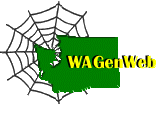Pioneer life in the Benton Co. WA area
Skates Were Homemade/Boys Turned Grindstone
By BURTON 0. LUM
Tri-City Pioneer
Tri-City Herald, Sunday, November 26, 1961, page 8
The ice skates of the pioneers were homemade. The materials from which they were formed were scarce. The pioneer boys and girls were constantly on the alert for pieces of oak or hard maple that were of a sufficient size from which skate forms or frames could be whittled.
The skates of those days were similar to the Old Country Holland skates with steel blades fastened to a wooden form and the forms strapped to the sole of the boot or shoe. The wooden forms had a large metal screw attached at the heel. A gimlet hole was drilled in the center of the boot or shoe heel and this screw was engaged in the hole.
When skates were taken off these holes had to be filled with cotton or rags to keep the dirt from filling them. This packing had to be picked out and replaced each time the skates were used. Two leather straps were required to buckle on each skate. It took quite some time to strap on the pair of skates. The runners, or blades of the skates were made by the blacksmith from used hoof rasps. These rasps were very hard steel and when heated by the blacksmith, were easily hammered and drawn to the required shape. After the blades were shaped, before they were tempered, the pioneer boy got plenty of exercise turning the grindstone while the blacksmith ground off the file and hammer marks. This done, he polished and sharpened the blades. As soon as the blades were shaped, ground and polished, they were tempered.
The Windslow clamp skate was invented about 1890. It clamped the skate onto the sole of the boot or shoe. The lever clamp was patented. It was easy to put on and take off. It did not give much support to.the foot and ankle. Supplementary straps were generally used.
The pioneer skating parties of Kennewick and Pasco were very enjoyable. When the ice became about eight inches thick, or thicker, and the moon was full, preparations were made for a skating party.
The best place to skate was in a bay formed by Hog Island and the Kennewick bank of the Columbia. During low water the entire flow of the Columbia passed between Hog Island and the Pasco bank. This bay was more than three-quarters of a mile long and about a half mile wide. Being in the lee of Hog Island, the ice was always smooth as glass. The skating party committee would have many teams of horses donated to drag driftwood in piles to make bonfires and mark the line of ice formed on the downstream part of the bay. There were always sufficient bonfires to light the pond. There would always be a spigoted keg of sorghum cider and tin cup. Seats were made of drift logs and placed at a comfortable distance from the fires. Every family had wooden sleds that had handles to push them like baby carriages. Every family brought lunches, coffee, tea, and milk, also plenty of blankets and robes, especially buffalo robes.
DeWit Owens of Pasco always brought his melodian with him. He did not play it himself, but there were always plenty of the pioneer women who could. Those who couldn’t skate sang songs, played games and visited. Captain Lum, Mrs. Lum and Fred Sonderman were excellent figure skaters and always gave a fine exhibition of fancy skating. There were always plenty of good skaters for a quadrille. Everyone enjoyed himself with plenty of healthful exercise and heard all the latest news of the neighborhood. At midnight Mrs. Lum played “Auld Lang Syne” and everyone, started for home.
Return to Index of Burton Lum Articles

